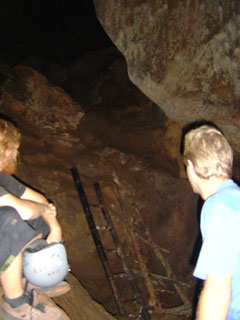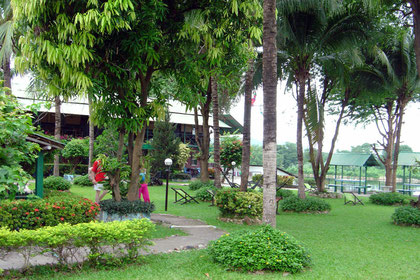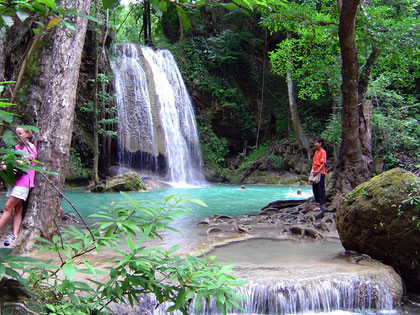Thailand
My trip to Thailand was executed with the least possible preparation. I took my seat on the plane to Bangkok lacking as much as a travel book or even a map of the area—or a watch, for that matter—fully reliant on my friend Kief’s offer to meet me at the airport on the other side. I didn’t even know how long the flight was supposed to take, so the fact that the plane was still operating on San Francisco time and telling me that I was arriving at 4:12 p.m.—rather than ten to midnight as I’d told Kief—left me wondering precisely how screwed I was about to become in a country I knew nothing about.
For the record, Thailand is two hours behind Japan, the flight takes six hours, and Kief was only about five minutes late—just enough to make me sweat.
Kief immediately introduced me to Khao San Road, an area of Bangkok that vividly illustrates why it’s so tempting for South-East Asian militants to bomb clubs that news reports invariably describe as being “frequented” by foreigners. The only locals on Khao San Road are trying to sell things to tourists, and the hotel I stayed in had posted a sign saying “No Thais Allowed.”
Room charges were contingent on whether you had a fan, air conditioning, a toilet or a shower—the latter two often being combined in a single tiled room, usually entirely devoid of toilet paper. If you were lucky, you would get a short little hose by the toilet. If you were unlucky, you would find a bowl floating in a tub of bleachy water, the operation of which eluded me until Kief explained why, in many parts of South-East Asia, it is considered rude to greet people using your left hand.
Over the ensuing ten days, although I managed never to pull myself more than three hours out of Bangkok’s gravity, I barely saw anything of the nation’s capital city.
Kanchanaburi
The next morning we fled for the hills of Kanchanaburi on a nice air-conditioned bus, where I was delighted to note that the seats rocked—until I revised my appraisal to note that the seats did not rock, but mine just happened to do so. Every few stops one or two people would get on the bus and hawk pop or snacks to the passengers before getting off a stop later.
Kanchanaburi is primarily known for the Bridge on the River Kwai, which is now staunchly defended by a regiment of knickknack shops. The region’s real marvels are the rivers and caves cutting their way through the limestone mountains.
Our next-door-neighbours at the unexpectedly nice Jolly Frog guesthouse were a pair of Torontonian girls, who, on their second night, permanently evacuated one of their beds because a gecko was spotted scampering behind it. In Thailand, this is like evacuating a house because it has oxygen in it. I think there are more geckoes than people. They cling to every neon sign like lime green suction cups.
On a hike along seven gorgeous limestone waterfalls (Ehrewan Falls), Kief and I “adopted” our young assistant guide, who taught me how to count to ten and say “hello” and “thank you” in Thai. In Thai, your statements end differently depending on your gender.
Between hiking and swimming in the cobalt blue waters, the sole gradually fell off my right boot, leaving me wandering barefoot by the evening. Getting them fixed cost more than it did to rent my room, but I now have the sturdiest MEC boots in Asia.
The Cave
The next morning, we rented scooters. This was a big adventure for me since I still cannot drive, and in Thailand you need only a passport to get a scooter.
In the parking lot at the Jolly Frog, Kief and I hovered over some unsuspecting victim’s scooter so he could show me how, from step one, to turn one on and make it move. Then we went to the rental shop and I tried to play cool.
We drove an hour and a half down a two-lane highway to another waterfall and a cave we’d spotted on the tourist map, while I was very careful to avoid doing anything that might cause me to die.
By this point, we’d picked up Sprocket, who was on the last leg of a year-long world tour, and spoke with a squeaky German accent that would make Dr. Strangelove proud.
The waterfall had quite a few tourists around it, while the cave, by contrast, looked like it hadn’t been pierced by a ray of light in a decade. We parked the scooters 2.5 km from the main road, then walked down a 1.2 km trail along which the only life we spotted was a single gigantic (1-inch diameter) potato bug being swarmed by a thousand big aggressive ants.
We’d also seen a cave on the waterfall tour the day before. That cave had been quite open, and even had a little light built into the back where it got tight. The cave Sprocket, Kief and I had found had a triangular opening about 10 feet high by 4 feet wide, with an old wooden ladder leading down into the murk below. We had a single flashlight that ran on AA batteries, and the batteries had to be taken from Sprocket’s camera. It didn’t work until Kief smacked it a few times. And then we went in.
What followed was a succession of instances of Kief and I saying, “Okay, let’s go back,” and Sprocket saying, “Just let me go ten feet further.” Every time he did that, he found another manhole-sized shaft in which someone had inserted a wooden ladder some decades ago, and he would proceed to descend with our one and only source of illumination, leaving us crouching in total darkness until he invariably called back up, “Hey! It really opens up down here!”
He did that three times. The last time, he found a chamber so big that there was a ladder going up to a higher section on the other side, and a big hole of nothing in the middle. There were also bats. I was waiting for an appearance by Harrison Ford.

The rocks were wet, and often looked organic. In one area, there were fins of stone running all the way down the walls that looked like ribs.
In that third chamber, we finally managed to convince Sprocket not to go exploring any further. It was a bit like demanding that your drunken buddy hand you his car keys.
When we got back to the place where we’d left our bikes, we found a small group of Thai men having lunch by the pond. We mentioned where we’d been and they nodded comprehendingly.
“Yeah, yeah. The cave.”
“Have you been down it?”
“Us? Heck no.”
Of course, this is a loose translation of a conversation consisting of monosyllables and gestures.
Ayutthaya
The next day, we were off to Ayutthaya. Ayutthaya was the capital of Thailand from 1350 to 1767, at which point the Burmese came in and flattened every last thing in sight. What’s left of it has been declared a UNESCO World Heritage Site, and the sheer density of ruined and standing temples makes Kyoto look sparse: the core of the town is an island surrounded by a moat-like rectangle of confluent rivers, and fully half of this island is temples.
Most of our travels there were done on bikes we rented at 50 baht for the day, and we were joined by J, a Torontonian killing time while she waited for her diving gear to arrive so she could go teach in the south. We encountered and re-encountered quite a few people over the course of our trip.
We happened to be temple-hopping on a public holiday, what I believe was the first day of the Buddhist “Lent,” during which the monks have to return to the temple by nightfall each day, and all the massive spires (“chedi”) of Wat Yai Chai Mongkhon were wrapped in yellow cloths, while people were applying gold foil to the Buddha statue out front.
The central chedi was quite large, guarded by rows of seated Buddha on the ground and two giant Buddha on either side of the long staircase that led up to a single, small chamber in which we found a ring of small golden Buddha and a ceiling full of bats. Enter an ancient structure in Thailand, and you will find yourself breathing bat guano.
The stately splendour of Wat Yai Chai Mongkhon was contrasted by the broken remnants of Wat Phra Mahathat, which was so completely shattered that the central tower (“prang”) was entirely gone, and of the rows of seated Buddha, nothing was left beyond their waists. A lone giant Buddha guarded the remains of the prang from the rear, apparently unaware that his charge had long since crumbled away. The various red-brick chedi were leaning at ominous angles, and within the grounds was the face of a Buddha that had been thoroughly absorbed by the roots of a tree, giving it an eerie presence.
There are signs at many of the temples discouraging visitors from sticking their heads on top of the decapitated statues for the purpose of taking snapshots.
There were also several newer temples with large golden Buddha within, as well as a large reclining Buddha at Wat Yai Chai Mongkhon, but none of these struck me as particularly impressive. They just looked new and mass-produced, even if they were several hundred years old. The only image that caught my attention was the 1300-year-old Buddha statue tucked away in a little building off to the side of Wat Phra Meru, which alone showed signs of craftsmanship. Beside the statue, an orange-robed monk sat beneath an A/C unit using a cell phone. Sadly, he spotted me trying to take a photo.
While we meandered about Wat Ratcha Burana, most notable in that its central prang and integrated burial chamber were left intact, we encountered some Thai high school students, who approached us to ask, “Excuse me, may I speak with you?” They had been sent out to interview foreigners for their English class. I had done the exact same thing with my students when they went to Kyoto. Even the questions were virtually identical.
“Where are you from…? What is your favourite temple…?”
Money, Money, Money
In Thailand, price is variable and relative value elusive. On Khao San Road in Bangkok, a windowless room exactly big enough for a double bed and space to tie your shoes cost 395 baht ($12). Meanwhile, at the “Jolly Frog” in Kanchanaburi, a spacious double room with shower, toilet, and fan came to a total of 150 baht for two people. A pancake breakfast could be as little as 15 baht (50 cents) and a Coke as little as 8, but a rum and coke never ran less than 70. And unless you could convince the attendant to leave you alone, a pee in a public toilet cost 2 baht.
People would try to sell you things at every turn, but if you were firm in demanding prices lower than they were willing to take, they’d leave you alone.
Swinging back through Bangkok, when we didn’t know the distance between the ferry dock on the Chao Phraya River and the train station that would link us to Ayutthaya, we were left us at the mercy of the taxis and tuk-tuks. A tuk-tuk is basically a scooter with a rickshaw carriage bolted to the back of it, and is probably your most consistent means of short-range transport in Thailand. Cabbies will usually pretend their meters are broken and charge you 200 baht for whatever distance you want to go, which is precisely what happened when Kief tried to hail us a cab by the river. After a moment’s negotiation, Kief just closed the door and told the guy to keep driving. Instead, we got on a tuk-tuk for 50 baht.
It turned out, however, that the station was just around the corner. Casting the driver a withering glance as I pulled out my wallet, he just smiled apologetically as if to say, “Hey, you snooze you lose!” I briefly joked about stiffing him, but didn’t. When you play the transportation game in Thailand, you have to play by the rules. Then we bought train tickets for the 80 km trip to Ayutthaya for 15 baht each—a third of the cost of our two-minute tuk-tuk.
Ko Samet & Out
After Ayutthaya, we spent a few drizzly days on the island of Ko Samet, on the way to which we were subjected to the abomination of Thai variety television. Imagine a bunch of people standing around hitting each other and falling down on a sound stage while every single motion, down to the slightest twitch, is accentuated by a Looney Tunes whoosh, boink, shoomp or kerplunk. Then imagine it playing non-stop on a bus you cannot escape for three hours.
On the island, we had a cabana that sat right on the edge of the beach. That was nice. I don't think the door actually closed, though.
In the end, excluding the plane tickets, my ten days in Thailand cost me only $200. It was only on the last day that I had to break a third $100 to buy gifts and pay the “departure tax” they nail you with when you leave the country.
Except for a few bills I reserved to show my students, I spent the last of my Thai money around 4:00 in the morning in a very empty airport as I awaited my 5:00 a.m. return flight to Japan. I had to pay 200 baht for a taxi from Khao San road, but it turned out to be about the right price anyway.









